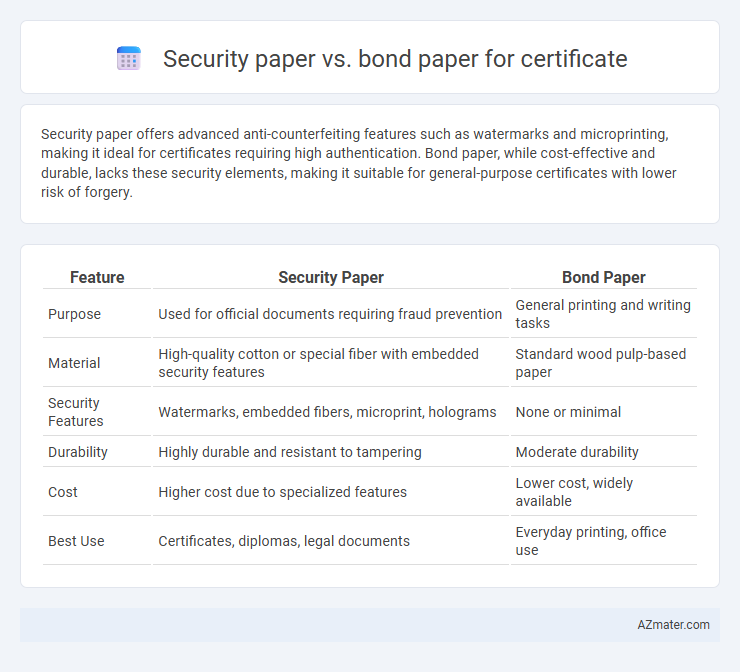Security paper offers advanced anti-counterfeiting features such as watermarks and microprinting, making it ideal for certificates requiring high authentication. Bond paper, while cost-effective and durable, lacks these security elements, making it suitable for general-purpose certificates with lower risk of forgery.
Table of Comparison
| Feature | Security Paper | Bond Paper |
|---|---|---|
| Purpose | Used for official documents requiring fraud prevention | General printing and writing tasks |
| Material | High-quality cotton or special fiber with embedded security features | Standard wood pulp-based paper |
| Security Features | Watermarks, embedded fibers, microprint, holograms | None or minimal |
| Durability | Highly durable and resistant to tampering | Moderate durability |
| Cost | Higher cost due to specialized features | Lower cost, widely available |
| Best Use | Certificates, diplomas, legal documents | Everyday printing, office use |
Introduction: Understanding Certificate Paper Types
Security paper incorporates specialized features such as watermarks, microprinting, and anti-copy patterns to prevent counterfeiting, making it ideal for official certificates requiring high authenticity. Bond paper, typically a high-quality, durable paper without security features, offers a cost-effective option for certificates where authenticity verification is less critical. Choosing between security paper and bond paper depends on the certificate's purpose, required security level, and budget constraints.
What is Security Paper?
Security paper is specialized paper embedded with features such as watermarks, microprinting, and security fibers designed to prevent forgery and counterfeiting, making it ideal for printing certificates. Unlike regular bond paper, security paper offers enhanced protection by visibly indicating tampering or duplication attempts. These intrinsic security elements ensure the authenticity and integrity of official documents like certificates.
What is Bond Paper?
Bond paper is a high-quality, durable writing paper commonly used for official documents, certificates, and letters due to its strength and smooth texture. It typically has a weight of 16 to 24 pounds and a slightly textured surface that enhances ink absorption and prevents smudging, making it ideal for professional printing. Unlike security paper, bond paper does not include built-in security features such as watermarks or anti-copy patterns, which limits its use in sensitive or fraud-prone applications.
Key Features of Security Paper for Certificates
Security paper for certificates incorporates distinctive features such as watermarks, micro-printing, and anti-counterfeit fibers to prevent forgery and ensure authenticity. Unlike standard bond paper, security paper often includes tamper-evident elements that reveal any attempt at alteration or duplication. These attributes make security paper an ideal choice for certificates requiring high integrity and protection against fraud.
Bond Paper Characteristics in Certificate Printing
Bond paper used in certificate printing offers durability and a smooth texture that enhances print clarity and professional appearance. Its high-quality fibers ensure resistance to wear and tear, maintaining the certificate's integrity over time. The slightly heavier weight of bond paper provides a substantial feel, making certificates appear more prestigious and official.
Security Paper vs Bond Paper: Durability Comparison
Security paper exhibits superior durability compared to bond paper, featuring embedded fibers, watermarks, and chemical treatments that resist tampering and aging. Bond paper, commonly used for everyday printing, lacks these security enhancements and tends to yellow and weaken over time when exposed to light and moisture. Certificates printed on security paper maintain structural integrity and authenticity longer, making them ideal for official documentation.
Cost Differences: Security Paper and Bond Paper
Security paper, designed with anti-counterfeit features such as watermarks and microprinting, typically costs 20-50% more than standard bond paper due to its specialized manufacturing process. Bond paper, commonly used for everyday printing and certificates, is more affordable and widely available but lacks inherent security elements, which can increase the risk of forgery. Organizations weighing cost differences must balance the higher investment in security paper against the potential losses and reputational damage from counterfeit certificates.
Anti-Forgery Features in Security Paper
Security paper used for certificates incorporates advanced anti-forgery features such as watermarks, microtext, holograms, and UV-reactive threads that are difficult to replicate, enhancing document authenticity. In contrast, standard bond paper lacks these specialized security elements, making certificates printed on it more susceptible to counterfeiting and unauthorized alterations. The integration of tamper-evident features in security paper provides a reliable solution for safeguarding important certificates against forgery and fraud.
Print Quality: Security Paper vs Bond Paper
Security paper offers superior print quality compared to bond paper, featuring embedded watermarks and micro-printing that enhance document authenticity and clarity. The specialized fibers and coating in security paper prevent smudging and ink bleeding, ensuring sharp, crisp text ideal for certificates. Bond paper lacks these features, often resulting in lower resolution prints and increased vulnerability to forgery.
Choosing the Best Paper for Certificates
Security paper offers enhanced protection against counterfeiting with features like watermarks, embedded fibers, and anti-copy patterns, making it ideal for certificates that require high authenticity and durability. Bond paper, typically smooth and lightweight, provides a cost-effective option suitable for everyday documents but lacks advanced security elements necessary for official certificates. Choosing the best paper depends on balancing security needs and budget, with security paper recommended for critical certifications that demand fraud prevention and long-term preservation.

Infographic: Security paper vs Bond paper for Certificate
 azmater.com
azmater.com